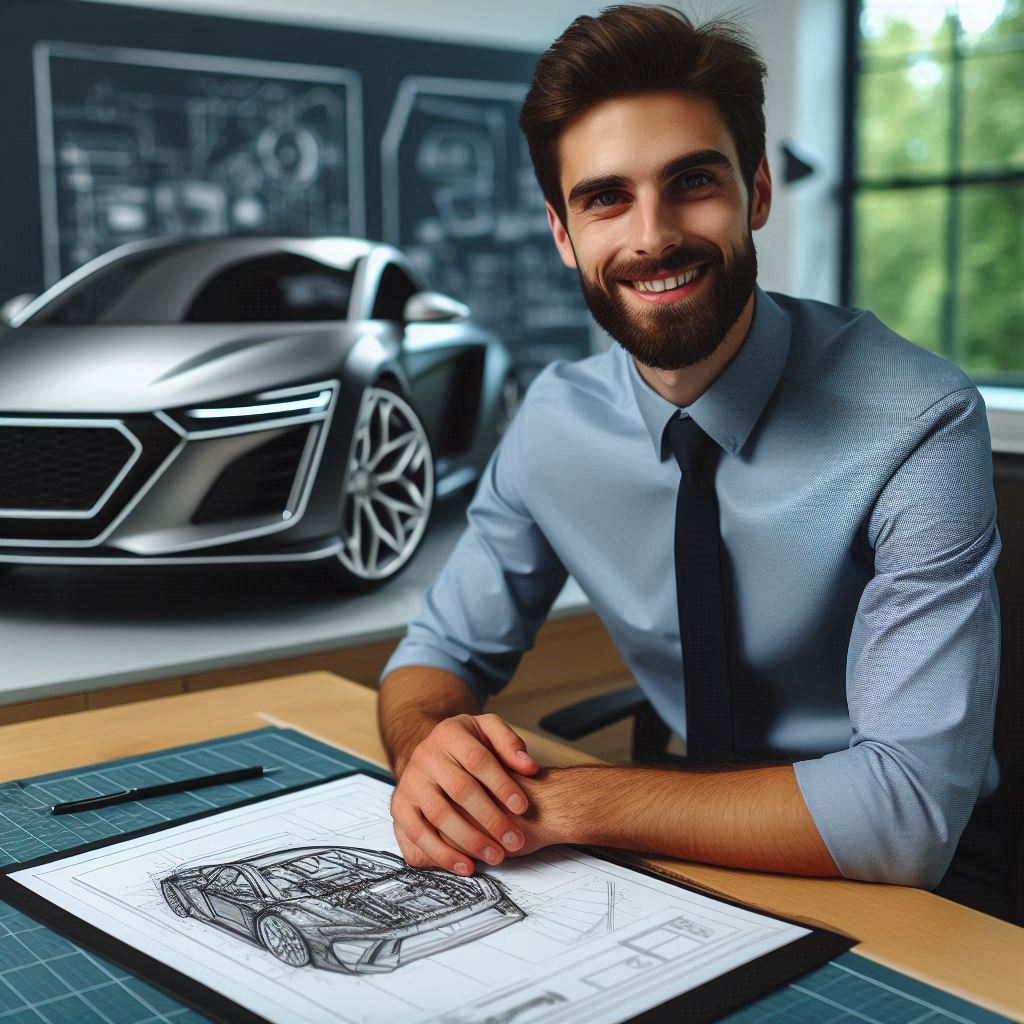Introduction
Automotive design trends are crucial for companies’ success.
In 2024, new trends are shaping the industry.
Design is a key factor in attracting customers and setting brands apart in the competitive automotive market.
In 2024, sustainability will be a top priority in automotive design, with a focus on eco-friendly materials.
Minimalism will also play a significant role, with clean lines and simplified interiors being prevalent in new vehicle designs.
Technology integration is another trend to watch out for in 2024, as more vehicles will feature advanced connectivity and autonomous driving capabilities.
Color trends are also expected to shift in 2024, with more vibrant and bold color choices becoming popular in automotive design.
Collaborations between automotive companies and fashion designers are set to continue, leading to unique and stylish vehicle designs in 2024.
Customization options will be on the rise in 2024, as customers seek personalized touches in their vehicles, from paint colors to interior features.
Sustainability, minimalism, technology integration, bold colors, collaborations, and customization will shape the automotive design landscape in 2024.
These trends reflect the evolving preferences of consumers and the innovative approaches of automotive companies to stay ahead in the market.
Sustainable Materials
The increased use of sustainable materials in car design
Car manufacturers are increasingly incorporating sustainable materials in their design process.
This trend is driven by the growing concern for the environment and the need to reduce the carbon footprint of vehicles.
Examples of eco-friendly materials being used in the automotive industry
One example of eco-friendly materials being used in the automotive industry is recycled plastics.
These plastics are sourced from recycled water bottles, packaging materials, and other plastics that would otherwise end up in landfills.
Importance of sustainability in influencing design choices
Another example is the use of natural fibers such as bamboo, hemp, and kenaf in car interiors.
These materials are not only sustainable but also provide a unique aesthetic appeal to the vehicles.
The importance of sustainability in influencing design choices cannot be overstated.
Consumers are becoming more conscious of the environmental impact of their purchases, and car manufacturers are responding to this demand by incorporating sustainable materials in their designs.
Read: Famous Automotive Designers in History
Transform Your Career Today
Unlock a personalized career strategy that drives real results. Get tailored advice and a roadmap designed just for you.
Start NowAutonomous Vehicles
With the rapid advancement of autonomous driving technology, the automotive industry is undergoing a significant transformation in terms of design.
Impact on Car Design
Autonomous driving technology is revolutionizing the way cars are designed.
Traditional features like steering wheels and pedals are becoming obsolete.
Designers are focusing on creating sleek and futuristic exteriors to reflect the cutting-edge technology inside.
Sensors and cameras are being integrated seamlessly into the design to enhance safety and functionality.
Redesigning Interiors
Interiors of self-driving cars are being transformed to maximize comfort and convenience for passengers.
Focus is on creating a lounge-like environment with reclining seats and advanced entertainment systems.
Flexible seating arrangements are being explored to cater to different needs and preferences.
Technological features like voice commands and gesture controls are being integrated for a seamless user experience.
The Future of Automotive Design
As autonomous vehicles become more prevalent, car design will continue to evolve.
Designers will have more freedom to experiment with unconventional shapes and materials.
Eco-friendly designs will be prioritized to align with the growing focus on sustainability.
Integration of artificial intelligence and smart technology will shape the future of automotive design.
In fact, the rise of autonomous vehicles is driving a paradigm shift in automotive design.
From futuristic exteriors to luxurious interiors, self-driving cars are reshaping the way we perceive and experience transportation.
Read: Automotive Designer Salary Guide
Electric Vehicles
As we look ahead to the automotive design trends in 2024, one of the most significant influences on design is the rise of electric vehicles.
This shift towards electric cars is not only changing the way we think about transportation but also the way we think about design.
How the rise of electric vehicles is influencing design trends
Electric vehicles are paving the way for a new era in automotive design.
Showcase Your Business Today
Reach thousands of readers actively exploring professional services. Publish your business profile and grow your audience now.
Publish NowWith the focus on sustainability and reducing carbon emissions, designers are tasked with creating vehicles that are not only functional but also environmentally friendly.
This emphasis on eco-friendliness has led to the integration of innovative technologies and materials in the design process.
One of the key ways in which electric vehicles are influencing design trends is through the implementation of aerodynamic features.
To maximize the efficiency of electric cars, designers are incorporating sleek and streamlined shapes that reduce air resistance and improve overall performance.
This focus on aerodynamics not only enhances the functionality of the vehicle but also gives it a futuristic and dynamic look.
Aerodynamic features and unique designs tailored to electric cars
Electric cars are not only efficient and environmentally friendly, but they also offer a unique platform for designers to explore innovative design concepts.
The absence of a traditional combustion engine provides greater flexibility in shaping the overall aesthetics of the vehicle.
This freedom has led to the development of futuristic designs that capture the imagination of consumers.
Designers are experimenting with bold geometric shapes, sharp angles, and unconventional materials to create electric cars that stand out on the road.
From sleek curves to edgy lines, electric vehicles are redefining what it means to be stylish and modern.
These unique designs are not only eye-catching but also serve a functional purpose in optimizing the performance of the vehicle.
Importance of aesthetics in attracting consumers to electric vehicles
While functionality and sustainability are important factors in the design of electric vehicles, aesthetics play a crucial role in attracting consumers to these innovative cars.
With the increasing demand for electric vehicles, automakers are focusing on creating visually appealing designs that appeal to a wide range of consumers.
Consumers are drawn to electric vehicles not only for their eco-friendly features but also for their sleek and futuristic designs.
The aesthetic appeal of electric cars has become a driving force in the adoption of electric vehicles as a mainstream mode of transportation.
As more consumers prioritize sustainability and style, automakers are responding by producing electric vehicles that not only perform well but also look good.
In short, the rise of electric vehicles is reshaping the landscape of automotive design in 2024.
With a focus on sustainability, aerodynamics, and aesthetics, designers are creating electric cars that are not only efficient and environmentally friendly but also visually stunning.
As we look towards the future, electric vehicles will continue to drive innovation in automotive design and set new standards for what a car can be.
Read: Art Therapy Techniques for Group Sessions

Connected Technology
Connected technology has become a driving force in the automotive industry, revolutionizing the design of vehicles and enhancing the overall driving experience.
This trend is expected to continue evolving in 2024, as automakers integrate more advanced features into their vehicles.
Overview of how connected technology is changing the design of vehicles
Modern vehicles are increasingly incorporating connected technology to provide a seamless driving experience.
This includes features such as GPS navigation, smartphone integration, in-car Wi-Fi, and advanced driver-assist systems.
These technologies not only improve convenience for drivers but also enhance safety and efficiency on the road.
The integration of connected technology has led to a shift in the design of vehicles, with a focus on creating intuitive interfaces and user-friendly controls.
Touchscreens, voice commands, and gesture controls are becoming common in modern car designs, allowing drivers to easily access information and control various functions while on the road.
Additionally, vehicle connectivity enables real-time data sharing, remote vehicle monitoring, and Over-The-Air (OTA) updates, ensuring that vehicles are always up to date with the latest software and features.
Examples of integrated technology features in modern car designs
- GPS navigation systems with real-time traffic updates
- Apple CarPlay and Android Auto for seamless smartphone integration
- In-car Wi-Fi for passengers to stay connected on the go
- Advanced driver-assist systems such as adaptive cruise control and lane-keeping assist
- Remote start and vehicle monitoring through mobile apps
These integrated technology features not only enhance the driving experience but also contribute to increased safety and convenience for drivers and passengers.
Role of connectivity in improving the overall driving experience
Connectivity improves the driving experience with various helpful features.
It enhances convenience by offering quick access to useful services.
Drivers benefit from added safety features while on the road.
Entertainment options keep drivers and passengers engaged during trips.
Connectivity ensures a smoother, safer, and more enjoyable drive.
One of the key benefits of connectivity is the ability to access real-time information such as traffic updates, road conditions, and weather forecasts, enabling drivers to make informed decisions and navigate efficiently.
This not only saves time but also reduces the likelihood of accidents and delays.
Moreover, connected technology allows for seamless integration of smartphones and other devices, providing drivers with access to apps, music, calls, and messages without taking their hands off the wheel.
This ensures that drivers remain focused on the road while staying connected to the outside world.
Additionally, connectivity enables remote vehicle monitoring and control, allowing drivers to check their vehicle’s status, lock/unlock doors, and even start the engine from a distance using a mobile app.
This level of convenience is especially useful in cold or hot weather conditions, as drivers can prepare their vehicle before getting in.
Showcase Your Business Today
Reach thousands of readers actively exploring professional services. Publish your business profile and grow your audience now.
Publish NowIn general, connected technology is driving significant changes in the automotive industry, with a focus on enhancing the overall driving experience through advanced features and services.
As this trend evolves, innovative technologies will integrate into vehicles.
These advancements will transform how we interact with cars.
They will make driving safer, more enjoyable, and efficient.
Expect continuous improvements in vehicle technology.
Read: Art and Design Careers: Breaking into the Industry
Minimalistic Design
In 2024, the automotive industry is seeing a significant shift towards minimalistic design.
Sleek and simple design elements are becoming increasingly popular in modern cars.
Car manufacturers are focusing on clean lines, smooth surfaces, and understated aesthetics.
Analysis of the Trend
This trend towards minimalism can be attributed to the desire for a more sophisticated and elegant look.
Consumers are gravitating towards designs that exude a sense of luxury and refinement.
Minimalistic designs also contribute to improved aerodynamics, resulting in better fuel efficiency.
Importance of Clean Interiors
One key aspect of minimalistic design is the emphasis on clean and uncluttered interiors.
A well-designed interior can enhance the overall user experience of the car.
Minimizing distractions and unnecessary features can create a more focused driving environment.
Benefits of Minimalistic Design
- Enhanced Aesthetics: Minimalistic designs offer a sleek, modern, and timeless look.
- Improved Functionality: Simplified interiors can make controls and features more intuitive to use.
- Reduced Weight: By eliminating excess materials, cars can be made lighter, improving performance and fuel efficiency.
- Eco-Friendly: Streamlined designs often result in more sustainable production processes and materials.
In general, minimalistic design is a prominent trend in the automotive industry for 2024.
Car manufacturers are embracing simplicity, elegance, and functionality to meet the evolving preferences of consumers.
By focusing on clean and uncluttered designs, automakers are not only creating visually appealing cars but also improving performance and user experience.
Customization Options
The growing demand for customization in car design
In 2024, one of the key trends in automotive design is the growing demand for customization in car design.
Customers are seeking unique features that reflect their personality and style, leading to a shift in the way vehicles are being designed and manufactured.
Examples of customizable features being offered by automotive companies
Here are some examples of customizable features being offered by automotive companies:
- Exterior color choices: Car manufacturers are now offering a wide range of color options, allowing customers to choose from a variety of shades and finishes to suit their preference.
- Interior upholstery: Customers can now select different types of materials, colors, and patterns for their car’s interior, creating a personalized and luxurious feel.
- Technology upgrades: Automotive companies are providing customization options for technology features such as infotainment systems, connectivity options, and driver assistance tools.
- Performance enhancements: Enthusiasts can now personalize their vehicles with performance upgrades, including engine tuning, suspension modifications, and aerodynamic enhancements.
Importance of personalizing vehicles to meet customer preferences
Personalizing vehicles to meet customer preferences is essential for automotive companies to stay competitive in the market.
By offering customization options, companies can attract a wider range of customers and cater to diverse tastes and preferences.
Moreover, customization allows customers to create a sense of ownership and emotional attachment to their vehicles, leading to increased brand loyalty and customer satisfaction.
As a result, automotive companies are investing more in research and development to offer innovative and unique customization options for their customers.
In review, the trend of customization in automotive design is here to stay in 2024 and beyond.
Customers want to express individuality through their vehicles.
Automotive companies respond by offering customizable features.
These options let buyers personalize every aspect.
Companies now provide a wide variety of choices. Customers can select everything from color to interior design.
Technology allows more advanced customization than ever before.
Brands compete to offer the most unique options.
This personalization helps drivers feel connected to their vehicles.
This trend not only benefits customers by allowing them to create their dream cars but also helps companies differentiate themselves in a competitive market.
Uncover the Details: Landing Your First Job as a Packaging Designer
Augmented Reality
Augmented Reality (AR) is revolutionizing the automotive industry in terms of design and technology.
It is shaping the future of car design by providing innovative solutions to enhance driver experience and vehicle functionality.
How augmented reality is shaping the future of car design
AR technology is enabling designers to visualize and experiment with new concepts in a virtual environment, speeding up the design process.
AR is facilitating the integration of advanced driver-assistance systems (ADAS) and autonomous driving features into vehicle design.
Designers can overlay digital information onto the physical world, allowing for the creation of interactive and customizable elements in vehicles.
Showcase Your Business Today
Reach thousands of readers actively exploring professional services. Publish your business profile and grow your audience now.
Publish NowAR features in navigation systems and driver displays
AR navigation systems provide real-time directional cues and information through head-up displays, reducing the need for drivers to look away from the road.
Driver displays with AR technology can project vital information such as speed, safety alerts, and navigation instructions onto the windshield.
These features enhance driving safety by keeping drivers informed while minimizing distractions caused by traditional dashboard displays.
Impact of AR on safety and convenience in vehicles
AR technology contributes to improved safety by enhancing driver awareness and reducing cognitive load through intuitive visual aids.
Features like augmented parking assistance help drivers maneuver in tight spaces by overlaying parking guidelines directly on the rearview camera feed.
AR-based maintenance guides provide step-by-step instructions for DIY repairs, simplifying vehicle upkeep and reducing maintenance costs.
In a nutshell, augmented reality is playing a pivotal role in shaping the future of automotive design.
From streamlining the design process to enhancing driver safety and convenience, AR technology is revolutionizing the way cars are designed and operated.
As the automotive industry continues to embrace AR innovations, we can expect to see even more exciting developments in vehicle design in the coming years.
Conclusion
Automotive design trends in 2024 are shaping up to be revolutionary in the industry.
From the focus on sustainability and eco-friendly materials to the integration of advanced technologies such as AI and AR, the future looks bright for car enthusiasts.
As automotive companies strive to innovate and differentiate themselves, staying updated with the latest design trends is crucial.
This not only ensures competitiveness but also drives creativity and consumer engagement.
The future of automotive design in 2024 is promising.
With a shift towards electric vehicles, autonomous driving features, and futuristic aesthetics, the automotive industry is on the cusp of a design renaissance.
Embracing these trends will be key for companies to succeed and thrive in the rapidly evolving market.
[E-Books for Sale]
The Big Book of 500 High-Paying Jobs in America: Unlock Your Earning Potential
$19.99 • 500 High-Paying Jobs • 330 pages
Explore 500 high-paying jobs in America and learn how to boost your career, earn more, and achieve success!
See All 500 High-Paying Jobs of this E-Book
1001 Professions Without a Degree: High-Paying American Jobs You Can Start Now
$19.99 • 1001 Professions Without a Degree • 174 pages
Discover 1001 high-paying jobs without a degree! Unlock career tips, skills, and success strategies for just $19.99!




